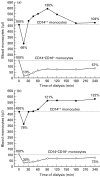Haemodialysis monocytopenia: differential sequestration kinetics of CD14+CD16+ and CD14++ blood monocyte subsets
- PMID: 11167997
- PMCID: PMC1905970
- DOI: 10.1046/j.1365-2249.2001.01436.x
Haemodialysis monocytopenia: differential sequestration kinetics of CD14+CD16+ and CD14++ blood monocyte subsets
Abstract
In peripheral blood the majority of circulating monocytes present a CD14highCD16- (CD14++) phenotype, while a subpopulation shows a CD14lowCD16+ (CD14+CD16+) surface expression. During haemodialysis (HD) using cellulosic membranes transient leukopenia occurs. In contrast, synthetic biocompatible membranes do not induce this effect. We compared the sequestration kinetics for the CD14+CD16+ and CD14++ monocyte subsets during haemodialysis using biocompatible dialysers. Significant monocytopenia, as measured by the leucocyte count, occurred only during the first 30 min. However, remarkable differences were observed between the different monocyte subsets. CD14++ monocyte numbers dropped to 77 +/- 13% of the predialysis level after 15 min, increasing to > or = 93% after 60 min. In contrast, the CD14+CD16+ subset decreased to 33 +/- 15% at 30 min and remained suppressed for the course of dialysis (67 +/- 11% at 240 min). Approximately 6 h after the end of HD the CD14+CD16+ cells returned to basal levels. Interestingly, the CD14+CD16+ monocytes did not show rebound monocytosis while a slight monocytosis of CD14++ monocytes was occasionally observed during HD. A decline in CD11c surface density paralleled the sequestration of CD14+CD16+ monocytes. Basal surface densities of important adhesion receptors differed significantly between the CD14+CD16+ and CD14++ subsets. In conclusion, during HD the CD14+CD16+ subset revealed different sequestration kinetics, with a more pronounced and longer disappearance from the blood circulation, compared with CD14++ monocytes. This sequestration kinetics may be due to a distinct surface expression of major adhesion receptors which facilitate leucocyte-leucocyte, as well as leucocyte-endothelial, interactions.
Figures




Similar articles
-
Strong depletion of CD14(+)CD16(+) monocytes during haemodialysis treatment.Nephrol Dial Transplant. 2001 Jul;16(7):1402-8. doi: 10.1093/ndt/16.7.1402. Nephrol Dial Transplant. 2001. PMID: 11427632
-
Biocompatibility study based on differential sequestration kinetics of CD14+CD16+ blood monocyte subsets with different dialyzers.Ren Fail. 2006;28(6):493-9. doi: 10.1080/08860220600781336. Ren Fail. 2006. PMID: 16928619
-
Haemodialysis-induced transient CD16+ monocytopenia and cardiovascular outcome.Nephrol Dial Transplant. 2009 Nov;24(11):3480-6. doi: 10.1093/ndt/gfp287. Epub 2009 Jul 8. Nephrol Dial Transplant. 2009. PMID: 19586969
-
CD14+CD16+ monocytes from chronic kidney disease patients exhibit increased adhesion ability to endothelial cells.Contrib Nephrol. 2011;171:57-61. doi: 10.1159/000327134. Epub 2011 May 23. Contrib Nephrol. 2011. PMID: 21625090 Review.
-
The three human monocyte subsets: implications for health and disease.Immunol Res. 2012 Sep;53(1-3):41-57. doi: 10.1007/s12026-012-8297-3. Immunol Res. 2012. PMID: 22430559 Review.
Cited by
-
The Complex Immunological Alterations in Patients with Type 2 Diabetes Mellitus on Hemodialysis.J Clin Med. 2024 Jun 25;13(13):3687. doi: 10.3390/jcm13133687. J Clin Med. 2024. PMID: 38999253 Free PMC article. Review.
-
Monocytes in Uremia.Toxins (Basel). 2020 May 21;12(5):340. doi: 10.3390/toxins12050340. Toxins (Basel). 2020. PMID: 32455723 Free PMC article. Review.
-
Immunomodulation and immunotherapeutics of COVID-19.Clin Immunol. 2021 Oct;231:108842. doi: 10.1016/j.clim.2021.108842. Epub 2021 Aug 27. Clin Immunol. 2021. PMID: 34461289 Free PMC article. Review.
-
Monocyte subpopulations and cardiovascular risk in chronic kidney disease.Nat Rev Nephrol. 2012 Mar 13;8(6):362-9. doi: 10.1038/nrneph.2012.41. Nat Rev Nephrol. 2012. PMID: 22410492 Review.
-
Adipose tissue immune response: novel triggers and consequences for chronic inflammatory conditions.Inflammation. 2014 Aug;37(4):1337-53. doi: 10.1007/s10753-014-9914-1. Inflammation. 2014. PMID: 24823865 Free PMC article. Review.
References
-
- Kaplow LS, Goffinet JA. Profound neutropenia during the early phase of hemodialysis. JAMA. 1968;203:1135–7. - PubMed
-
- Stuard S, Carreno M-P, Poignet J-L, Albertazzi A, Haeffner-Cavaillon N. A major role for CD62P/CD15s interaction in leukocyte margination during hemodialysis. Kidney Int. 1995;48:93–102. - PubMed
-
- Kaupke CJ, Zhang J, Cesario T, Yousefi S, Akeel N, Vaziri ND. Effect of hemodialysis on leukocyte adhesion receptor expression. Am J Kidney Dis. 1996;27:244–52. - PubMed
-
- Tabor B, Geissler B, Odell R, Schmidt B, Blumenstein M, Schindhelm K. Dialysis neutropenia. The role of the cytoskeleton. Kidney Int. 1998;53:783–9. - PubMed
Publication types
MeSH terms
Substances
LinkOut - more resources
Full Text Sources
Medical
Research Materials

